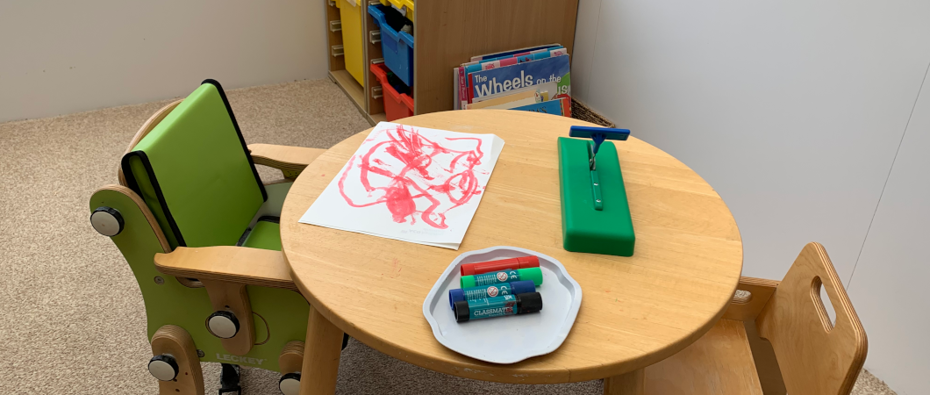Page Contents

Enabling Environments
- Provide developmentally appropriate resources.
- Support children to choose their play activities where they have challenges engaging spontaneously or difficulty accessing the range of opportunities. This could be through a choice board, verbal choices, showing the child around the environment, offering a choice of two objects, first-then board (particularly useful where children lack the confidence to move to another activity).
- Give the child a choice of activity if they have difficulty spontaneously engaging or “get stuck” on a singular activity through an appropriate means e.g., showing two objects relating to the activities, choosing a board or a signed or verbal choice.
- Scaffolding support to play with new toys and activities, modelling to children how to use the resources in their play.
- Supporting children to engage with peers alongside self-chosen activities.
- Consider children’s interests, preferred schema, experiences, developmental level, and next steps when planning activities and the environment, building these into the chosen resources and activities to ensure intrinsic motivation, increase engagement, and attention, to build on their skills and understanding.
- Ensure the environment is visually supportive to the children in accessing resources e.g., photos on boxes, boxes put back in consistent places etc.
- Respect and celebrate children’s play styles and interests, particularly where children’s play follows a schematic pattern or is particularly repetitive.
- Sensitively follow the interests of individual children, make connections, and build on these.
Consider how to present resources and activities to reduce the cognitive and sensory load e.g.:
- building blocks on a plain coloured fleece blanket to reduce the sound of them clattering together
- placing a reduced amount of building blocks on a tray so the child does not become overwhelmed by the amount
- having a plain tablecloth at a sticking activity rather than a busy patterned one so the child can focus on the available resources.
- Break down tasks into small steps, using forward or backward chaining as appropriate.
- Model new skills.
- Ensure there are opportunities to revisit and reinforce learning.
- Present activities in a routine and with repetition.
- Ensure there are repeated opportunities to generalise new skills and embed previously learnt ones.
- Present learning experiences via meaningful first-hand experiences e.g., learning unfamiliar words using real objects and experiences.
- Use errorless learning: teaching a child a new skill by using prompts to guide a child through each step correctly and not allowing them to fail.
- Start and finish baskets or boxes.
- Build on children’s strengths and interests.
- Provide an area where there are limited sensory distractions e.g., quieter, plain walls, plain table, away from the bustle of the group where a child can focus for short periods.
- Allow the child time to process instructions (ten seconds).
- Reduce language.
- Slow language down.
- Give more time to process language, communication, and experiences.
- Use visuals, objects, signs, and gestures to support language.
- Create a quieter space, with reduced distractions.
(See the Communication section for a fuller explanation)
- Ensure the size of the group for group times are appropriate to the development and needs of all children, this may mean creating smaller groups.
- Consider the space in which you have group times are they in low arousal spaces to make it easier to concentrate on the group time activity e.g., no other activities going on in the background, it is easier to concentrate on the person or book if they are not sat in front of a busy display.
- Group times are planned to the developmental needs and interests of the children in the group.
- Group times are an appropriate time for the age and development of the group, some children may need this to be shorter, only joining in for a part of it and gradually increasing time in the group. It is usually preferable to join in for the end and finish with the group rather than being taken off during the session.
- Consider alternatives to using group times as “time fillers” for routine transitions, but where group times are used for this purpose, these also need to be motivating, engaging, meaningful and developmentally appropriate in both content and timings.
- The use of visuals to support group times are used routinely to support engagement, understanding and attention e.g., story props, song bags, key pictures.
- Signing is used during group time to support communication, this is helpful for many children, but particularly those with additional needs, where a child is using BSL or Makaton as their means of communication setting should use this system.
- The use of visual expectations can be helpful in group times e.g., sitting, looking.
- The use of a group visual timetable will aid understanding of what will be next after group time but consider the use of a visual timetable for group time as well if there is more than one element e.g., talking, story, singing.
- Group time activities are motivating and meaningful to the children’s interests and developmental needs.
- Settings carefully consider the children’s needs within the group and plan for these: choose books, songs, and activities appropriate to children’s needs and interests, consider using the same book for a week or more for children to engage with increasing understanding and recall, supplement these.
- Some children will benefit from an individual matching book, set of pictures or objects relevant to the story to support engagement, attention and understanding.

